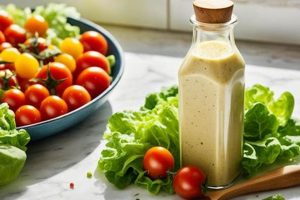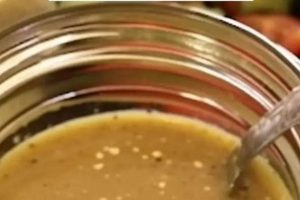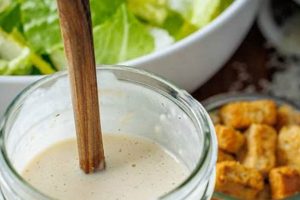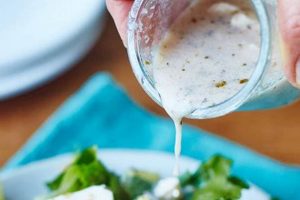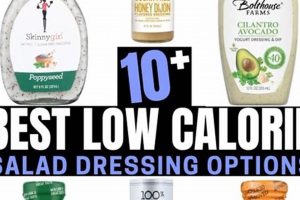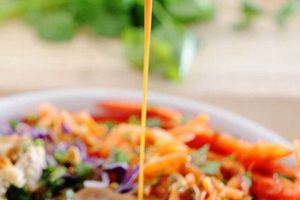A blend of balsamic vinegar, oil, and often other flavoring agents creates a tangy, sweet, and savory emulsion used to enhance the flavors of salads and other dishes. A classic example involves extra virgin olive oil, balsamic vinegar, Dijon mustard, honey, salt, and pepper. Variations can incorporate ingredients such as garlic, shallots, herbs, or maple syrup.
The rich, complex flavor profile of this culinary staple contributes depth and enjoyment to a wide range of dishes. Its versatility allows for adaptation to various cuisines and preferences, making it a popular choice for both home cooks and professional chefs. Historically, balsamic vinegar originated in Modena, Italy, and was traditionally aged for years, resulting in a costly and prized product. More readily available versions allow wider accessibility to this flavorful ingredient in dressings.
Exploring the nuances of ingredient selection, ratios, and emulsion techniques provides a foundation for crafting delectable dressings. This understanding also opens avenues for experimentation and personalization, allowing for the creation of unique flavor combinations to complement any culinary creation.
Tips for Crafting Exceptional Balsamic Dressings
Elevating a simple salad or dish often hinges on the quality of the dressing. Attention to detail and thoughtful ingredient selection are crucial for achieving optimal flavor and texture.
Tip 1: Quality Ingredients Matter: Begin with high-quality balsamic vinegar. Aged varieties offer complex, nuanced flavors. Select a good extra virgin olive oil for its fruity notes and health benefits.
Tip 2: Balance is Key: Strive for a harmonious balance of sweet, sour, and savory elements. Adjust ratios of vinegar, oil, and sweeteners to achieve the desired profile.
Tip 3: Emulsification Techniques: Proper emulsification creates a smooth, creamy texture and prevents separation. Whisk ingredients vigorously or use a blender for a stable emulsion.
Tip 4: Freshly Cracked Pepper: Freshly cracked black pepper adds a subtle bite and enhances the overall flavor complexity. Pre-ground pepper lacks the same aromatic intensity.
Tip 5: Experiment with Flavor Combinations: Incorporate complementary ingredients such as Dijon mustard, honey, maple syrup, garlic, shallots, or herbs to create unique flavor profiles.
Tip 6: Taste and Adjust: Taste the dressing throughout the preparation process and adjust seasonings as needed. Palates vary, so customization is essential.
Tip 7: Proper Storage: Store leftover dressing in an airtight container in the refrigerator for up to one week. Allow to come to room temperature before serving.
By following these guidelines, one can consistently create flavorful and well-balanced dressings that enhance the culinary experience.
These tips provide a foundation for exploring the versatility of balsamic-based dressings and encourage experimentation within the kitchen.
1. Ingredients
The foundation of any successful balsamic salad dressing recipe lies in the careful selection and combination of its ingredients. Each component contributes distinct characteristics that influence the final flavor profile, texture, and overall quality of the dressing. Understanding the role of each ingredient is paramount to achieving desired results.
- Balsamic Vinegar
The defining ingredient, balsamic vinegar provides the characteristic tangy sweetness. Quality significantly impacts the final product; aged balsamic offers complex, nuanced flavors while younger versions provide a sharper acidity. Choosing the right balsamic is the first step towards a successful dressing.
- Oil
Oil acts as the emulsifying agent, binding the ingredients and creating a smooth, creamy texture. Extra virgin olive oil is a common choice due to its fruity notes and health benefits, but other oils like avocado or grapeseed oil can offer unique flavor profiles. The oil’s flavor and viscosity directly influence the dressing’s mouthfeel and overall taste.
- Sweetener
Balancing the acidity of balsamic vinegar often requires a sweetener. Honey, maple syrup, or granulated sugar are popular choices, each offering a distinct sweetness and subtle flavor nuances. The type and amount of sweetener used dictates the final balance and overall sweetness of the dressing.
- Additional Flavorings
A wide range of ingredients can enhance the complexity of a balsamic dressing. Dijon mustard adds a subtle tang, while garlic or shallots provide pungent notes. Fresh or dried herbs like oregano, thyme, or rosemary introduce aromatic complexity. These additions offer opportunities for customization and creativity, tailoring the dressing to specific preferences and culinary applications.
The interplay of these ingredients determines the ultimate character of the balsamic salad dressing. Careful consideration of each component and their respective contributions is essential for achieving a well-balanced and flavorful result. The quality of ingredients, their proportions, and the way they interact ultimately determine the success of the recipe.
2. Proportions
Proportions play a critical role in the final outcome of a balsamic salad dressing recipe. The ratio of oil to vinegar significantly influences the dressing’s texture, mouthfeel, and overall balance. A higher proportion of oil creates a richer, more viscous dressing, while a higher vinegar concentration results in a thinner, tangier consistency. Achieving the desired balance hinges on careful measurement and adjustment according to individual preferences. For example, a classic vinaigrette typically employs a 3:1 ratio of oil to vinegar, while a more intense balsamic reduction dressing might utilize a 1:1 ratio or even invert the proportions. The interplay of these ratios directly impacts the overall flavor profile and how the dressing coats and complements the ingredients of a salad.
Beyond the core oil and vinegar ratio, the proportions of other ingredients, such as sweeteners and flavor enhancers, also contribute significantly to the final product. Adding too much sweetener can overpower the tanginess of the balsamic, while insufficient sweetness might leave the dressing overly acidic. Similarly, an excessive amount of garlic or other pungent flavors can dominate the delicate balance, masking the subtle nuances of the balsamic vinegar. Understanding these proportional relationships empowers one to adjust and fine-tune the recipe to achieve the desired flavor profile, ensuring a harmonious blend of sweet, sour, and savory notes. A practical example involves starting with a basic 3:1 oil-to-vinegar ratio and gradually adjusting the sweetener and additional flavorings incrementally, tasting and re-evaluating at each stage until the desired balance is achieved.
Mastery of proportions is essential for crafting consistently delicious and well-balanced balsamic salad dressings. Careful consideration of ingredient ratios, combined with iterative adjustments and taste testing, allows for the creation of dressings tailored to individual preferences and culinary applications. The ability to manipulate proportions provides a pathway to explore variations, personalize recipes, and ultimately enhance the culinary experience. This understanding transforms a simple recipe into a versatile tool for culinary expression.
3. Emulsification
Emulsification is crucial for the texture, stability, and sensory experience of a balsamic salad dressing recipe. It involves combining two immiscible liquids, typically oil and vinegar, into a stable mixture where tiny droplets of one liquid are dispersed throughout the other. This process prevents the dressing from separating into its constituent parts, ensuring a smooth, creamy consistency rather than a layered, oily appearance. Achieving a stable emulsion is vital for delivering a consistent flavor profile and an appealing mouthfeel. Without proper emulsification, the oil and vinegar separate, leading to an uneven distribution of flavor and a less desirable texture. The process relies on the presence of an emulsifying agent, which helps to reduce the surface tension between the two liquids and facilitate the formation of small, stable droplets.
In the context of a balsamic salad dressing recipe, several factors contribute to successful emulsification. Vigorous whisking by hand provides mechanical energy to break down the oil into smaller droplets and disperse them throughout the vinegar. Alternatively, using a blender or food processor offers a more efficient method for creating a stable emulsion. The addition of emulsifying agents, such as Dijon mustard or honey, further aids in stabilizing the mixture. These agents contain molecules with both hydrophilic (water-loving) and lipophilic (oil-loving) properties, allowing them to bridge the gap between the oil and vinegar and maintain a uniform dispersion. For example, the lecithin in egg yolks is a powerful emulsifier and can be used to create a particularly stable and creamy balsamic vinaigrette. The choice of oil also influences emulsion stability. Extra virgin olive oil, due to its higher viscosity and inherent emulsifying properties, contributes to a more stable dressing compared to less viscous oils.
Understanding the principles of emulsification empowers one to create superior balsamic salad dressings. A stable emulsion ensures a consistent flavor experience with each bite, delivering the balanced sweet and tangy notes of the balsamic vinegar evenly throughout the salad. The smooth, creamy texture enhances the overall sensory experience, making the salad more palatable and enjoyable. Furthermore, a stable emulsion improves the cling of the dressing to the salad ingredients, ensuring that every leaf is adequately coated. Practical applications of this knowledge extend beyond simple vinaigrettes; it applies to the creation of more complex balsamic reductions, marinades, and sauces, enhancing their texture and stability. Challenges may arise when using highly acidic balsamic vinegar or when incorporating ingredients that interfere with emulsion stability. However, careful ingredient selection, appropriate emulsification techniques, and awareness of potential destabilizing factors can mitigate these challenges, ensuring consistent, high-quality results. This understanding enables predictable control over the texture and stability of balsamic-based culinary creations, elevating the dining experience.
4. Flavor Balance
Flavor balance is paramount in a successful balsamic salad dressing recipe. The hallmark of a well-executed dressing lies in the harmonious interplay of sweet, sour, salty, and sometimes bitter or umami notes. This balance prevents any single flavor from dominating, creating a complex and nuanced profile that complements, rather than overpowers, the other ingredients in a dish. The inherent sweetness of balsamic vinegar, derived from the cooked grape must, provides a natural foundation. However, the intensity of this sweetness can vary greatly depending on the age and quality of the vinegar. Therefore, achieving optimal balance necessitates careful consideration of the vinegar’s inherent sweetness and the judicious addition of other ingredients. For example, a robust, aged balsamic vinegar with pronounced sweetness might require less added sugar than a younger, more acidic balsamic.
The interplay of acidity and sweetness forms the core of flavor balance in balsamic dressings. Balancing the tangy acidity of the vinegar with a complementary sweetener, such as honey, maple syrup, or granulated sugar, is essential. This balance ensures the dressing is neither overly sharp nor cloyingly sweet. Furthermore, the addition of salt plays a crucial role, not only in enhancing overall flavor perception but also in modulating the perceived sweetness and acidity. A pinch of salt can subtly round out the flavor profile, preventing the dressing from tasting flat or one-dimensional. Other flavor components, such as Dijon mustard, garlic, shallots, or herbs, add complexity and depth. Dijon mustard contributes a subtle tanginess and helps emulsify the dressing, while garlic or shallots introduce pungent notes that complement the balsamic’s sweetness. Fresh or dried herbs provide aromatic complexity, further enhancing the overall flavor profile. A classic example involves balancing the sweetness of a 12-year aged balsamic vinegar with a touch of honey, a pinch of salt, and a dollop of Dijon mustard, creating a harmonious flavor profile that enhances a simple salad of fresh greens and tomatoes.
Mastering flavor balance in balsamic salad dressing recipes requires careful attention to detail and an understanding of how different ingredients interact. The success of the final product hinges on the harmonious interplay of flavors, where each component contributes to the overall profile without dominating the others. Challenges may arise when using balsamic vinegars with varying levels of sweetness or when incorporating ingredients with strong inherent flavors. However, incremental adjustments and frequent taste-testing throughout the preparation process allow for fine-tuning the balance and achieving the desired outcome. This meticulous approach enables the creation of balsamic dressings that enhance the culinary experience, transforming a simple salad into a more complex and satisfying dish.
5. Customization
Customization is integral to the versatility of balsamic salad dressing recipes. It allows adaptation to individual preferences, seasonal ingredient availability, and specific culinary applications. The inherent adaptability of a basic balsamic vinaigrette provides a foundation for exploration and creativity. Modifying ingredients, proportions, and flavor combinations allows for the creation of dressings tailored to specific needs and preferences. This flexibility distinguishes balsamic vinaigrette as a versatile culinary tool, capable of enhancing a wide range of dishes beyond simple salads.
The ability to customize balsamic salad dressings stems from the simplicity of its core components: oil, vinegar, and seasonings. This basic framework allows for a wide range of variations. Substituting different oils, such as avocado or walnut oil, for the traditional olive oil introduces unique flavor profiles. Incorporating diverse sweeteners, from honey and maple syrup to agave nectar or even fruit preserves, alters the sweetness and complexity of the dressing. Furthermore, the addition of fresh or dried herbs, spices, garlic, shallots, or other aromatics allows for seemingly endless flavor combinations. For example, a balsamic dressing intended for a Caprese salad might benefit from the addition of fresh basil and oregano, while a dressing for a grilled steak salad might be enhanced by the inclusion of smoked paprika and a touch of Dijon mustard. These customized variations offer the opportunity to create dressings that perfectly complement the flavors of the accompanying dish.
Understanding the principles of customization unlocks the full potential of balsamic salad dressing recipes. It empowers experimentation, encourages culinary creativity, and allows for the development of unique flavor profiles tailored to individual preferences and specific culinary needs. While challenges may arise in balancing complex flavor combinations or achieving desired textural characteristics, thoughtful consideration of ingredient interactions and careful adjustments typically yield successful results. This capacity for customization elevates balsamic vinaigrette beyond a simple dressing, transforming it into a versatile and adaptable culinary staple. The practical significance of this understanding lies in the ability to create dressings that not only complement but enhance the flavors of a diverse range of dishes, from simple green salads to more complex composed plates.
6. Storage
Proper storage is essential for maintaining the quality, flavor, and safety of balsamic salad dressings. Because these dressings often contain perishable ingredients like fresh herbs, garlic, or shallots, they are susceptible to spoilage if not stored correctly. Improper storage can lead to undesirable changes in flavor, texture, and even the development of harmful bacteria. Refrigeration is crucial for inhibiting bacterial growth and preserving the freshness of the dressing. Storing the dressing in an airtight container prevents oxidation, which can negatively impact flavor and contribute to rancidity, particularly in dressings containing oils. For example, a balsamic vinaigrette containing fresh minced garlic should be stored in a sealed container in the refrigerator to prevent both spoilage and the development of off-flavors. The practical significance of proper storage lies in extending the shelf life of the dressing, minimizing waste, and ensuring its quality and safety for consumption.
The storage duration of balsamic salad dressings varies depending on the specific ingredients. Dressings made with only oil and vinegar generally have a longer shelf life, often lasting up to a week in the refrigerator. However, the addition of fresh ingredients, such as herbs, garlic, or shallots, significantly reduces the storage time, typically limiting it to 3-5 days. Emulsified dressings are generally more stable than non-emulsified ones, as the emulsification process helps prevent separation and maintain a homogenous mixture. Regularly inspecting the dressing for signs of spoilage, such as changes in color, texture, or the development of unpleasant odors, is crucial for ensuring food safety. If any of these signs are present, the dressing should be discarded immediately. Practical applications of this understanding include labeling prepared dressings with the date of preparation to facilitate proper stock rotation and minimize the risk of consuming spoiled dressing.
Effective storage practices are an integral component of any balsamic salad dressing recipe. They ensure the preservation of flavor, texture, and safety, maximizing the enjoyment and minimizing the risk of foodborne illness. While challenges may arise due to ingredient variability and storage conditions, adherence to proper refrigeration techniques and vigilance in monitoring for signs of spoilage mitigate these risks. This understanding allows for the safe and prolonged enjoyment of homemade balsamic salad dressings, contributing to both culinary satisfaction and food safety practices.
Frequently Asked Questions
The following addresses common inquiries regarding balsamic salad dressing recipes, offering practical guidance and clarifying potential points of confusion.
Question 1: How can one prevent balsamic vinaigrette from separating?
Proper emulsification is key. Vigorous whisking or the use of a blender helps create a stable emulsion. Adding a small amount of Dijon mustard or honey also aids in binding the oil and vinegar together.
Question 2: What type of balsamic vinegar is best suited for salad dressings?
While aged balsamic vinegars offer complex flavors, they can be costly. A good quality, commercially available balsamic vinegar provides a balanced flavor profile suitable for most dressings.
Question 3: Can balsamic salad dressings be made ahead of time?
Yes, they can be prepared in advance and stored in an airtight container in the refrigerator for up to a week. However, dressings containing fresh ingredients like herbs or garlic should be used within 3-5 days.
Question 4: How can one adjust the sweetness of a balsamic dressing?
Sweetness can be adjusted by adding small amounts of honey, maple syrup, or granulated sugar. Taste and adjust incrementally until the desired level of sweetness is achieved.
Question 5: What are some common mistakes to avoid when making balsamic vinaigrette?
Common mistakes include using low-quality ingredients, improper emulsification techniques, and neglecting to taste and adjust seasonings throughout the preparation process. Overpowering the delicate balance of flavors with excessive amounts of garlic or other pungent ingredients is also detrimental to the final result.
Question 6: Beyond salads, what other dishes benefit from balsamic dressing?
Balsamic dressings are incredibly versatile. They can be used to marinate meats, drizzle over roasted vegetables, or even as a glaze for grilled fish. Their complex flavor profile adds depth and richness to a variety of culinary applications.
Understanding these key aspects of balsamic vinaigrette preparation ensures successful and flavorful results, empowering culinary exploration and enjoyment.
Further exploration of balsamic vinaigrette recipes can involve delving into specific variations, exploring regional adaptations, or examining the health benefits associated with individual ingredients.
balsamic salad dressing recipe
Exploration of balsamic salad dressing recipes reveals a nuanced interplay of ingredients, proportions, and techniques. Quality ingredients form the foundation, with extra virgin olive oil and balsamic vinegar providing the core flavor profile. Proper emulsification ensures a desirable texture, while careful attention to flavor balance harmonizes sweet, sour, and savory notes. Customization through herbs, spices, and other additions allows for personalized flavor profiles tailored to specific culinary applications. Proper storage techniques maintain quality and extend shelf life.
Mastery of these elements allows adaptation and innovation within this classic culinary staple. The potential for flavor exploration and personalized creation within balsamic salad dressing recipes remains a testament to its enduring appeal and versatility. Continued experimentation and refinement promise further evolution and enjoyment within the culinary landscape.

